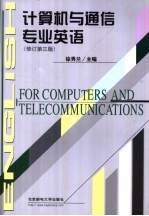图书介绍
计算机与通信专业英语 修订第3版pdf电子书版本下载

- 徐秀兰主编 著
- 出版社: 北京:北京邮电大学出版社
- ISBN:7563503358
- 出版时间:2003
- 标注页数:352页
- 文件大小:6MB
- 文件页数:361页
- 主题词:
PDF下载
下载说明
计算机与通信专业英语 修订第3版PDF格式电子书版下载
下载的文件为RAR压缩包。需要使用解压软件进行解压得到PDF格式图书。建议使用BT下载工具Free Download Manager进行下载,简称FDM(免费,没有广告,支持多平台)。本站资源全部打包为BT种子。所以需要使用专业的BT下载软件进行下载。如 BitComet qBittorrent uTorrent等BT下载工具。迅雷目前由于本站不是热门资源。不推荐使用!后期资源热门了。安装了迅雷也可以迅雷进行下载!
(文件页数 要大于 标注页数,上中下等多册电子书除外)
注意:本站所有压缩包均有解压码: 点击下载压缩包解压工具
图书目录
UNIT 1 A New Computing Model—Pervasive(Ubiquitous)Computing 1
1-1 What Is Pervasive Computing? 1
1-2 Challenges to Pervasive Computing 3
1-3 Turn Pervasive Computing into Mediated Spaces 5
Reading Material:Smart Spaces and Hardware Prototypes 8
Exercises 11
UNIT 2 Computer Systems 13
2-1 Why Should People Care of a Computer System? 13
2-2 What Should People Do with a Computer System? 14
2-3 Designing for Performance 17
2-4 Pentium and PowerPC Evolution 21
Exercises 24
UNIT 3 Design Technologies of CPU 27
3-1 The Complex Instruction Set Computer—CISC 27
3-2 Definition of Reduced Instruction Set Computer—RISC 29
3-3 VLIW Microprocessors 34
Exercises 35
UNIT 4 Primary-Memory Organization and I/O Devices 38
4-1 Primary-Memory Organization 38
4-2 External Devices and Their Control 42
4-3 I/O Devices 45
Exercises 49
UNIT 5 Operating System 53
5-1 What Is an Operating System? 53
5-2 Operating System Structure 55
5-3 Case Study:Windows 2000 60
5-4 What Is Linux? 65
Exercises 68
UNIT 6 Programming 71
6-1 Programming Languages 71
6-2 The Need for a New Style of Programming 73
6-3 What Is Object-orientation? 76
6-4 Visual Programming 80
6-5 What Is Java? 84
Exercises 86
UNIT 7 Database Systems 89
7-1 Introduction to Database System 89
7-2 Describing and Storing Data in a DBMS 91
7-3 Parallel Databases 95
7-4 Distributed Databases 98
Exercises 102
UNIT 8 Decision Support Systems 105
8-1 Introduction to Decision Support 105
8-2 Data Warehousing 107
8-3 On-Line Analytic Processing 109
8-4 Data Mining 114
Exercises 118
UNIT 9 Basic Concepts of Pattern Recognition 121
9-1 What Are The Pattern Recognition and Classification Problems? 121
9-2 Approaches to Recognition and Classification 126
9-3 Features and Their Distributions 129
Exercises 131
UNIT 10 Computer Networks 134
10-1 What Is a Network? 134
10-2 The Major Types of Networks 136
10-3 Network Protocols 145
10-4 IPv6 Overview 152
Exercises 155
UNIT 11 Network Security 158
11-1 Where Do Security Threats Come from? 158
11-2 Encryption Methods 160
11-3 Access Control 164
11-4 Firewalls:Internet Socurity 170
Exercises 175
UNIT 12 Multimedia 178
12-1 What Is Multimedia? 178
12-2 Multimedia Hardware 180
12-3 Multimedia Networking 183
12-4 Multimedia Software:Applications 185
12-5 Defining Hypertext,Hypermedia and Multimedia 188
Exercises 193
UNIT 13 Digital Sound Technology 195
13-1 The Physics of Sound 195
13-2 Digital Sampling 197
13-3 Sampling Theory Meets Multimedia 203
Exercises 205
UNIT 14 Image Processing 207
14-1 Representation of Images 207
14-2 Image Data Compression 209
14-3 A Practical Drawing Program of"Computer Graphics" 216
Exercises 220
UNIT 15 Broadband ISDN and ATM 222
15-1 Basic Concepts of B-ISDN 222
15-2 ATM—a Mechanism ofTransporting and Switching Information forB-ISDN 224
15-3 The B-ISDN Reference Model 228
Exercises 231
UNIT 16 Satellites 234
16-1 Satellite Fundamentals 234
16-2 Uplinks and Downlinks 236
16-3 Satellite Antenna Design 237
16-4 Two-degree Satellite Spacing and the Antenna Performance Standard 238
Exercises 240
UNIT 17 Optical Fiber Communications 242
17-1 The General System 242
17-2 Advantages of Optical Fiber Communication 245
17-3 Optical Light Sources and Optical Detectors 248
Exercises 252
UNIT 18 Mobile Wireless Personal Communications 255
18-1 Radio Technology and Personal Communication Concepts 255
18-2 CDMA and Other Spectrum Sharing Concepts 257
18-3 Development of GSM 259
18-4 Third-Generation(3G)Wireless Technology 261
Reading Material:Examples of Existing CDMA System 263
Exercises 264
UNIT 19 Access Network(Subscriber Loop)Technologies 267
19-1 The Migration from Copper to Optical Fiber Subscriber Loops 267
19-2 Extending the Life of Copper Subscriber Loops 269
19-3 The High-bit-rate Digital Subscriber Loop(HDSL) 270
19-4 The Asymmetric Digital Subscriber Loop(ADSL) 273
19-5 Hybrid Fiber-coax Access Networks 275
Exercises 277
UNIT 20 New Computing Types in the Future 280
20-1 Introduction to Optical Computing 280
20-2 High Performance Processing System of the Future 282
20-3 An Overview of Quantum Computing 285
Reading Material:Quantum Computer Today 288
Exercises 290
Answers/习题解答 292
Translations for Texts(Partial)/参考译文(部分) 299
Bibliography/参考文献 324
List of New Words/词汇表 326